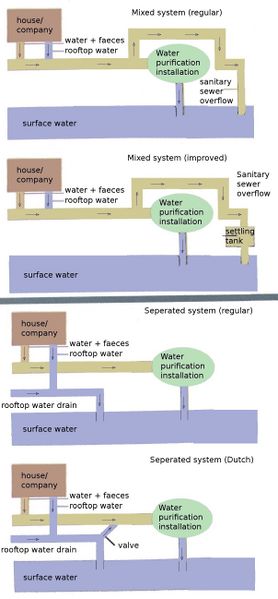
Original file (1,205 × 2,596 pixels, file size: 297 KB, MIME type: image/jpeg)
A schematic of the different types of sewerage systems. The schematic was based on the schematics of BartvO (see http://upload.wikimedia.org/wikipedia/commons/e/e1/Gemengd_stelsel.gif, http://upload.wikimedia.org/wikipedia/commons/1/1c/Gescheiden_stelsel.gif Note that mixed systems only relay water+feaces directly to the surface water in case the system becomes oversaturated (eg in case of extensive rain). It does not relay water+feaces to the surface water all the time. In time, all systems (no matter whether mixed or seperate) will need to be converted to a seperated composting toilet/rainwater system; the schematic here only shows the differences in the sewerage systems so as to allow easier conversion. Conversion can be done simply by disconnecting the faeces+water pipe from the system and swapping it with a composting toilet. Note that "rain water pipes" connected to the road need to be seen as main sewerage pipes (thus not as rain water pipes). This is because most roads (obviously with the exeption of concrete roads) are made of fossil oil products and thus pollute the rainwater when it comes in contact with the road. Thus, rainwater pipes connected to the roads need to pass trough the purification installation first.
File history
Click on a date/time to view the file as it appeared at that time.
| Date/Time | Thumbnail | Dimensions | User | Comment | |
|---|---|---|---|---|---|
| current | 15:36, 25 January 2010 |  | 1,205 × 2,596 (297 KB) | KVDP (talk | contribs) | A schematic of the different types of sewerage systems. The schematic was based on the schematics of BartvO (see http://upload.wikimedia.org/wikipedia/commons/e/e1/Gemengd_stelsel.gif, http://upload.wikimedia.org/wikipedia/commons/1/1c/Gescheiden_stelsel. |
You cannot overwrite this file.
File usage
The following file is a duplicate of this file (more details):
- File:Sewerage system types.JPG from Wikimedia Commons
The following page uses this file: